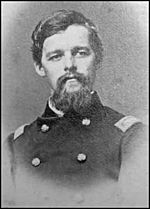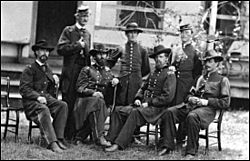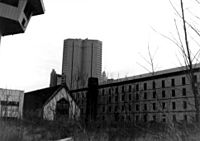Charles C. Walcutt facts for kids
Quick facts for kids
Charles Carroll Walcutt
|
|
|---|---|

Charles Carroll Walcutt
|
|
| Born | February 12, 1838 Columbus, Ohio |
| Died | May 2, 1898 (aged 60) Omaha, Nebraska |
| Place of burial |
Green Lawn Cemetery, Columbus, Ohio
|
| Allegiance | United States of America Union |
| Service/ |
United States Army Union Army |
| Years of service | 1861–1866 |
| Rank | |
| Commands held | 46th Ohio Infantry |
| Battles/wars | American Civil War |
Charles Carroll Walcutt (born February 12, 1838 – died May 2, 1898) was an American surveyor, a soldier, and a leader in politics. He was also a cousin to the famous Davy Crockett. Walcutt served as a general in the Union Army during the American Civil War. He was injured twice during the war.
After the war, Walcutt became the head of a large prison in Ohio, called the Ohio State Penitentiary. He was also very active in community activities in Ohio. His death was linked to injuries he got during the Civil War.
Early Life and Family
Charles Carroll Walcutt was born in 1838 in Columbus, Ohio. His father, John M. Walcutt, made chairs, and his mother was Mariel Broderick. Charles had three sisters. His grandmother on his mother's side was a first cousin of Davy Crockett. Both his father and grandfather had served in the United States military. His father fought in the War of 1812, and his grandfather fought in the American Revolutionary War.
Walcutt went to school in the Columbus area. In 1854, he joined the Kentucky Military Institute in Lyndon, Kentucky. He finished his studies in June 1858. He planned to become a civil engineer, which is someone who designs and builds things like roads and bridges. The next year, he was chosen as the surveyor for Franklin County. A surveyor measures land.
In 1860, Walcutt married Phebe Neill. She was born in Belfast, Ireland. Her father, Hugh Neill, was an officer in the British Army. Charles and Phebe had three sons: J. Macy, Sherman, and Charles Carroll Jr. Charles Walcutt Jr. also became an Army officer. He reached the rank of brigadier general, leading a government office called the Bureau of Insular Affairs.
Serving in the Civil War
When the American Civil War started in 1861, Walcutt decided to support his home state and the Union cause. On April 15, he gathered a group of soldiers in Columbus. He was made their captain on April 17. However, Ohio already had enough soldiers, so Walcutt's group was not accepted by the Federal army.
That June, he became a major in the state forces. He worked for Ohio Militia Brig. Gen. Charles W. Hill in what is now West Virginia.
In the fall, Walcutt helped create and train the 46th Ohio Infantry regiment. He became a major in this regiment on October 1. On January 30, 1862, he was promoted to lieutenant colonel. Walcutt went to Paducah, Kentucky, for duty in February. In March, he traveled with the army up the Tennessee River. The 46th Ohio fought for the first time on April 6 at the Battle of Shiloh. In this battle, Walcutt was shot in his left shoulder. The bullet stayed in his shoulder for the rest of his life.
Walcutt was promoted to colonel on October 16, 1862. He then took command of the 46th Ohio. He led his regiment in the Vicksburg Campaign in Mississippi. This campaign lasted from December 1862 to July 1863. During the campaign, Walcutt fought in the Union victory at the Battle of Jackson on May 14.
He then fought bravely at the Battle of Missionary Ridge in Chattanooga, Tennessee, from November 23 to 25. When Brig. Gen. John M. Corse was badly wounded, Walcutt took command of his brigade. He led his soldiers and held their position "against repeated charges by superior numbers." After the battle, his commander, Maj. Gen. William T. Sherman, praised Walcutt. Sherman recommended him for a promotion. Sherman wrote that Walcutt "filled his part manfully" and "continued the contest, pressing forward at all points."
The entire brigade signed up to serve again on January 5, 1864. Walcutt was very happy about this. After leaving Chattanooga, he continued to lead the brigade. He fought in the Atlanta Campaign that summer. Walcutt was part of the Battle of Kennesaw Mountain on June 27 and the Battle of Atlanta on July 22. He was promoted to brigadier general on July 30. His hometown newspaper wrote about his actions near Atlanta:
The men fought to the front, flank and rear; and at one time Colonel Walcutt was ordered to retire, as he was almost completely surrounded; but, feeling confident of holding his position, he disobeyed the order, and, as he was successful in his efforts, his disobedience cost him nothing. The Atlanta campaign was one continuous battle to Walcutt's brigade, but it brought him a brigadier generalship.
Walcutt then took part in Sherman's March to the Sea in November and December 1864. He again fought with courage at the Battle of Griswoldville on November 22. He was wounded again there. His brigade of about 1,500 men helped Union cavalry. They held a defensive spot at Duncan's Farm against attacks from poorly trained Confederate soldiers from Georgia. The Union army lost fewer than 100 men, including Walcutt. The Confederates lost many more. Walcutt was injured early in the fight. Command of the brigade went to Col. Robert F. Catterson. Sherman praised Walcutt again in his report. Maj. Gen. Oliver O. Howard said Walcutt was "not a braver or better officer." Walcutt was hit in his right leg by a piece of a cannon shell. He was out of action for several months.
By April 4, 1865, Walcutt had recovered enough to command the 1st division of the XIV Corps. He led them in the grand review (a big parade) in Washington, D.C., until June 12. After the war ended, he led his command to Louisville, Kentucky. His soldiers finished their service as volunteers there in August. Walcutt served in the western part of the country until he left the Union Army on January 15, 1866. For his actions at Griswoldville, President Andrew Johnson gave Walcutt the honorary rank of brevet major general of volunteers. This rank was effective from March 13, 1865.
After the War
After the war, Walcutt returned home. In 1866, he became the head of the Ohio Penitentiary in Columbus. On July 28, he was made a lieutenant colonel in the 10th U.S. Cavalry. He went to Fort Leavenworth, Kansas, for duty. However, he resigned on December 1, 1866. He said he "unwilling to endure army life in time of peace." Walcutt went back to Ohio and worked as a prison warden until 1869.
Walcutt was also active in politics in Ohio. In 1868, he was one of the people who voted for Ulysses S. Grant for president in the Electoral College. In May, President Grant appointed him as the tax collector for the 7th district of Ohio. He held this job until July 1, 1883. In 1872, Walcutt was elected to the Columbus school board. He was president of the board for seven years, until April 1, 1894. Also in 1872, he was a delegate to the Republican National Convention in Philadelphia, Pennsylvania.
In April 1883, he was elected mayor of Columbus. He was elected for a second term and retired in April 1887. His wife Phebe died the next year.
In 1898, Walcutt was in Omaha, Nebraska. He was on his way back to Ohio after visiting Mexico with his sister Virginia to improve his health. His condition got worse in Omaha, and he stayed there for about six weeks. Ten days before he died, doctors had to remove one of his limbs. His body was brought back to Ohio and buried in Green Lawn Cemetery in Columbus.




